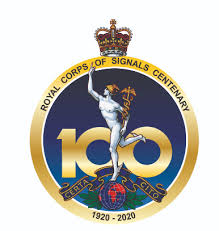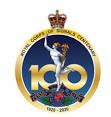


On 28 June 1920 Winston Churchill, the Secretary of State for War, signed a Royal Warrant to form a Corps of Signals from the Royal Engineers Signalling Service. Six weeks later King George V conferred the title Royal Corps of Signals.
The Territorial Army and its predecessors had provided units of the RE Signalling Service since before the First World War but the Kent and Sharpshooters Yeomanry (KSY)’s connection with the Royal Signals comes from the major reorganisations of the late 1960s.
Yeomanry units were formed in Kent in the 1790s to counter the threat of invasion from France. The Sharpshooters were created in 1899 as yeomanry in the County of London at the time of the Boer War. Regiments of Kent and Sharpshooters Yeomanry served with distinction in both world wars and merged together in 1961.
In 1967 the KSY was reduced from a regiment to a single armoured reconnaissance squadron, based at Croydon. This continues to serve proudly today as C (KSY) Squadron of the Royal Yeomanry.
The remainder - the regimental headquarters at Bromley, and the sabre squadrons at Maidstone, Ashford and in Central London - were disbanded or transferred to a home defence organisation called AVR (Army Volunteer Reserve) III. Those at Bromley joined territorial anti-aircraft artillery units at Bexleyheath and Camberwell to form the London & Kent Volunteers (Royal Artillery). AVR III had minimal funding but kept skills and units alive and provided the seedcorn for the expansion into a revived TA in 1969.
The soldiers at Bromley and Bexleyheath now formed the regimental headquarters for a new signals regiment based in and around London. The regiment became 71 (Yeomanry) Signal Regiment and the Sharpshooters formed 265 (London & Kent), later 265 (KCLY) Signal Squadron within the regiment. The three digit squadron number is unique in the Army Reserve Royal Signals and reflected a special request by those who had served at Bexleyheath as part of 265 (Light Anti Aircraft) Regiment Royal Artillery to preserve at least part of their identity.
265 Signal Squadron expanded throughout the 1970s and 1980s, steadily acquiring a greater communications role. By 1985, when the major home defence exercise “Exercise Brave Defender” was held, it had three large communications troops, one of which was now based at Brighton, and was organised and equipped to provide a communications hub for wartime military communications across London and South East England.
In 1987 it celebrated a visit by HRH The Princess Royal, Colonel in Chief of the Royal Signals, who opened its new, and now purpose-designed, training centre at Bexleyheath. A second Sharpshooters squadron was also created at Bexleyheath to take on headquarters and administrative functions for the regiment. The squadrons were merged again in 2010 as part of a reduction and refocusing of the army’s reserve forces and a switch from formed independent units to individuals working within regular army units.
The Royal Signals of today provide the battlefield communications and information systems essential to all military operations. Royal Signals units provide the full telecommunications infrastructure for the Army wherever they operate in the world. The Corps has its own engineers, logistics experts and systems operators to run radio and area networks in the field. It is responsible for installing, maintaining and operating all types of telecommunications equipment and information systems, providing command support to commanders and their headquarters, and conducting electronic warfare against enemy communications.
Our Sharpshooters today serve either as 265 (Kent & County of London Yeomanry (Sharpshooters)) Support Squadron, 71 (Yeomanry) Signal Regiment which wears the cap badge of the Royal Signals and shoulder flashes marked 'KCLY’, based in Bexleyheath, or as part of the Royal Armoured Corps as C Squadron Royal Yeomanry based in Croydon. .